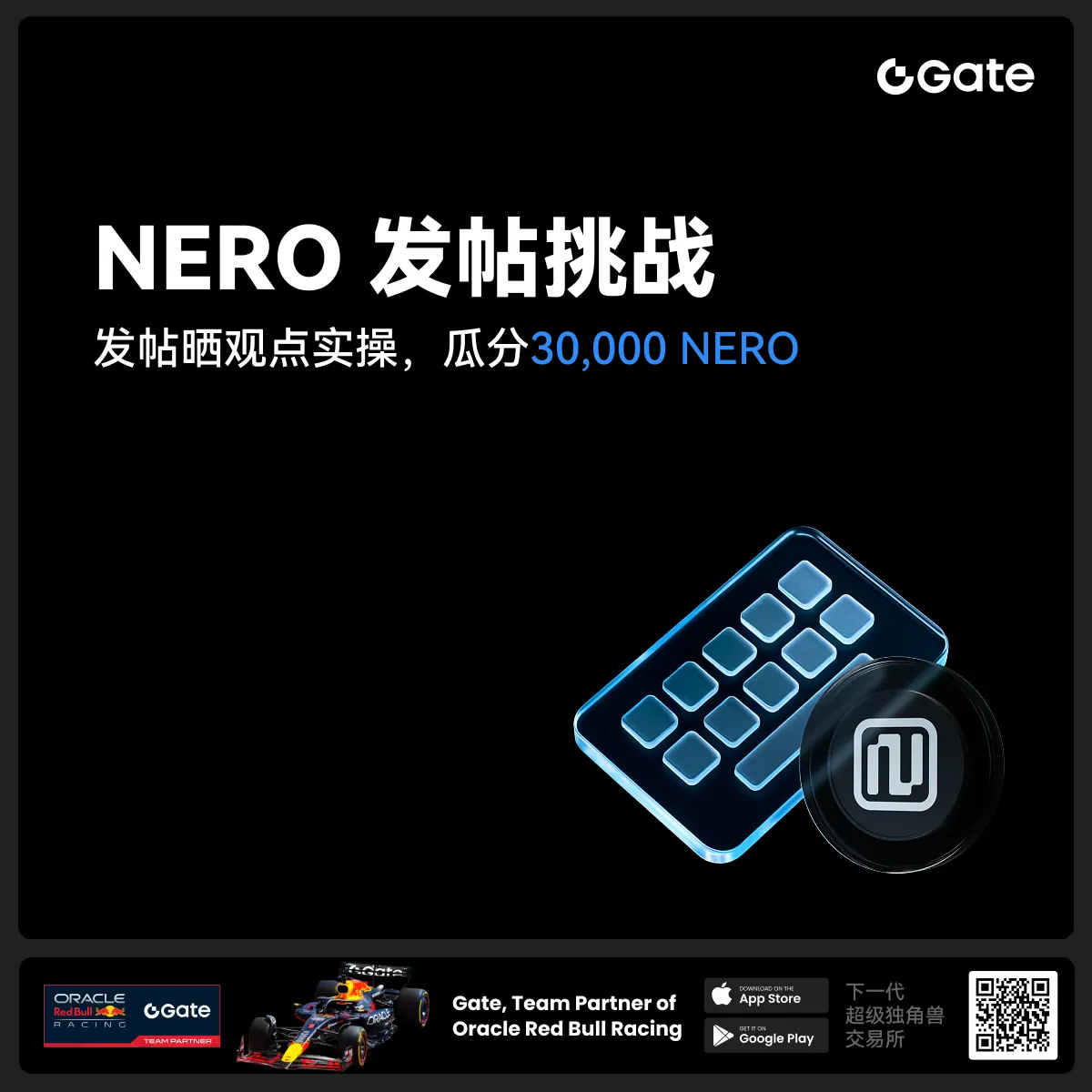- 话题1/3
78129 热度
55654 热度
71837 热度
9245 热度
23327 热度
- 置顶
- 🎉 #CandyDrop合约挑战# 正式开启!参与即可瓜分 6 BTC 豪华奖池!
📢 在 Gate 广场带话题发布你的合约体验
🎁 优质贴文用户瓜分$500 合约体验金券,20位名额等你上榜!
📅 活动时间:2025 年 8 月 1 日 15:00 - 8 月 15 日 19:00 (UTC+8)
👉 活动链接:https://www.gate.com/candy-drop/detail/BTC-98
敢合约,敢盈利
- 🎉 攒成长值,抽华为Mate三折叠!广场第 1️⃣ 2️⃣ 期夏季成长值抽奖大狂欢开启!
总奖池超 $10,000+,华为Mate三折叠手机、F1红牛赛车模型、Gate限量周边、热门代币等你来抽!
立即抽奖 👉 https://www.gate.com/activities/pointprize?now_period=12
如何快速赚成长值?
1️⃣ 进入【广场】,点击头像旁标识进入【社区中心】
2️⃣ 完成发帖、评论、点赞、发言等日常任务,成长值拿不停
100%有奖,抽到赚到,大奖等你抱走,赶紧试试手气!
截止于 8月9日 24:00 (UTC+8)
详情: https://www.gate.com/announcements/article/46384
#成长值抽奖12期开启#
- 📢 Gate广场 #NERO发帖挑战# 秀观点赢大奖活动火热开启!
Gate NERO生态周来袭!发帖秀出NERO项目洞察和活动实用攻略,瓜分30,000NERO!
💰️ 15位优质发帖用户 * 2,000枚NERO每人
如何参与:
1️⃣ 调研NERO项目
对NERO的基本面、社区治理、发展目标、代币经济模型等方面进行研究,分享你对项目的深度研究。
2️⃣ 参与并分享真实体验
参与NERO生态周相关活动,并晒出你的参与截图、收益图或实用教程。可以是收益展示、简明易懂的新手攻略、小窍门,也可以是行情点位分析,内容详实优先。
3️⃣ 鼓励带新互动
如果你的帖子吸引到他人参与活动,或者有好友评论“已参与/已交易”,将大幅提升你的获奖概率!
NERO热门活动(帖文需附以下活动链接):
NERO Chain (NERO) 生态周:Gate 已上线 NERO 现货交易,为回馈平台用户,HODLer Airdrop、Launchpool、CandyDrop、余币宝已上线 NERO,邀您体验。参与攻略见公告:https://www.gate.com/announcements/article/46284
高质量帖子Tips:
教程越详细、图片越直观、互动量越高,获奖几率越大!
市场见解独到、真实参与经历、有带新互动者,评选将优先考虑。
帖子需原创,字数不少于250字,且需获得至少3条有效互动
- 🎉 亲爱的广场小伙伴们,福利不停,精彩不断!目前广场上这些热门发帖赢奖活动火热进行中,发帖越多,奖励越多,快来GET你的专属好礼吧!🚀
1️⃣ #GateLaunchpad上线IKA# |IKA认购体验
在Gate广场带话题晒出你的IKA Launchpad认购体验,4位幸运分享者讲瓜分$200分享奖池!
详情 👉️ https://www.gate.com/post/status/12566958
2️⃣ #ETH冲击4800# |行情分析预测
大胆发帖预测ETH走势,展示你的市场洞察力!10位幸运用户将平分0.1 ETH 奖励!
详情 👉️ https://www.gate.com/post/status/12322403
3️⃣ #创作者活动第二期# |ZKWASM话题
在广场或推特发布与 ZKWASM 或其交易活动相关的原创内容,瓜分4,000枚ZKWASM!
详情 👉️ https://www.gate.com/post/status/12525794
4️⃣ #Gate广场征文活动第二期# |ERA话题
谈谈你对ERA的观点/体验,参与并推广活动,700 ERA大奖等你赢!
详情 👉️ https://www.gate.com/post/status/12361653
5️⃣ #MBG任务挑战# |MBG话题
分享你对MBG的洞察,积极参与和推广MBG活动,20位小
RWAs build mirrors where they need building blocks
Opinion by: Jakob Kronbichler, co-founder and CEO of Clearpool and Ozean
Real-world assets (RWAs) onchain aren’t just a concept anymore — they’re gaining real traction
Stablecoins are proof of that. They’ve become a dominant source of onchain volume, with annual transfers surpassing Visa and Mastercard by 7.7% last year. Tokenized US Treasurys are gaining interest from institutions hunting for yield.
Stablecoins represent more than just successful tokenization. They’ve evolved into financial infrastructure. They’re not merely digitized dollars but programmable money that other applications build upon
This platform dynamic separates winners from the many struggling RWA projects; most tokenized assets are designed as digital replicas when they should be architected as building blocks.
Tokenization does not equate to adoption
You can tokenize everything — that doesn’t mean it’s useful.
Take a quick look at RWA dashboards, and you’ll see growing total value locked, more issuers and increased attention. But most of that value sits in several wallets with minimal integration into decentralized finance (DeFi) ecosystems.
This isn’t liquidity; it is parked capital.
Early RWA models focused on wrapping assets for custody or settlement, not making them usable within the constraints of DeFi. Legal classification compounds the issue, constraining how and where assets can move.
Stablecoins succeeded because they solved infrastructure problems, not just representation ones. They enable instant settlement, eliminate pre-funding for cross-border flows and integrate seamlessly into automated systems. Most RWAs are still designed as digital certificates rather than functional components of a broader financial stack.
That’s starting to change. Newer designs are compliance-aware and DeFi-compatible. Adoption will follow when tokenized assets are built to integrate, not just to exist
Integration isn’t just a technical challenge.
Compliance is the bottleneck
The biggest chokepoint for RWA growth is legal. When a tokenized T-bill is classified as a security offchain, it remains a security onchain. That limits what protocols it can interact with and who can access it.
So far, the workaround has been to create gated DeFi: KYC’d wallets, allowlists and permissioned access. But this approach kills composability and fragments liquidity, which are the very traits that make DeFi powerful in the first place.
While token wrappers may improve accessibility, they can’t resolve the underlying regulatory status. Legal structuring has to come first.
The Senate’s passage of the GENIUS Act marks a significant step forward, establishing a federal framework for stablecoins backed 1:1 by Treasurys. It’s the clearest sign yet that compliant, auditable digital assets are moving from the fringe to the core of institutional finance.
This shift will enable RWAs to evolve from static representations into usable, scalable financial instruments.
Liquidity hasn’t caught up to the narrative
One of the strongest value propositions of RWAs is liquidity: 24/7 access, faster settlement and real-time transparency. However, most tokenized assets today trade like private placements, characterized by thin volume, wide spreads and limited secondary market activity.
Liquidity has lagged because regulated assets can’t move freely across DeFi. Without interoperability, markets stay siloed.
Related: RWA backing: How do issuers ensure 1:1 peg with tokenized assets?
Stablecoins show that liquidity comes from composability. When currencies like the euro and Singapore dollar exist as programmable tokens, treasury operations transform from multi-step processes to instant cross-border transactions. Most tokenized assets miss out because they’re designed as endpoints rather than interoperable components.
The solution isn’t more tokens. What’s needed is an infrastructure designed for both sides of the bridge with built-in compliance and transparency that meets institutional expectations.
Institutions need an upgrade
From an institutional perspective, most existing systems might be clunky, but they’re compliant. They work well enough. Without a step-change in efficiency, cost or compliance, migrating to blockchain is a hard sell. That changes when RWA infrastructure is purpose-built for institutional workflows.
When compliance isn’t just bolted on but structurally integrated. When connections to liquidity, institutional-grade custody and reporting are seamless, they are not stitched together
That’s what it’ll take to make going onchain worthwhile.
DeFi needs assets it can use
RWAs were intended to bridge the gap between DeFi and traditional finance. But right now, many are stuck somewhere in between.
As institutions inch closer to onchain integration, DeFi protocols face the challenge of adapting their infrastructure to support assets with real-world constraints.
DeFi’s most-used assets are still native: stablecoins, Ether (ETH) and liquid staking tokens (LSTs). Tokenized RWAs remain largely siloed, unable to participate in lending markets, collateral pools or yield strategies
Legal restrictions around asset classification and user access mean some protocols can’t support them, at least not without significant modification.
That’s starting to change. We’re seeing new primitives designed to make RWAs composable within controlled environments, bridging compliance and usability without compromising
This evolution is critical: It will make RWAs functionally relevant inside DeFi, not just adjacent to it.
Every institution needs a tokenization strategy
The first wave of institutions is now choosing its tokenization strategy. The difference between winning and losing comes down to platform thinking: building infrastructure that others can build upon, not just wrapping assets in digital form
Just as every company needed a mobile strategy in 2010 and a cloud strategy in 2015, institutions now need a plan for tokenized assets.
The companies that recognize this shift early will architect their systems to participate in and potentially control the emerging tokenized economy
Those who wait will be stuck building on someone else’s platform, with limited control, less flexibility and less upside.
Opinion by: Jakob Kronbichler, co-founder and CEO of Clearpool and Ozean.
This article is for general information purposes and is not intended to be and should not be taken as legal or investment advice. The views, thoughts, and opinions expressed here are the author’s alone and do not necessarily reflect or represent the views and opinions of Cointelegraph.